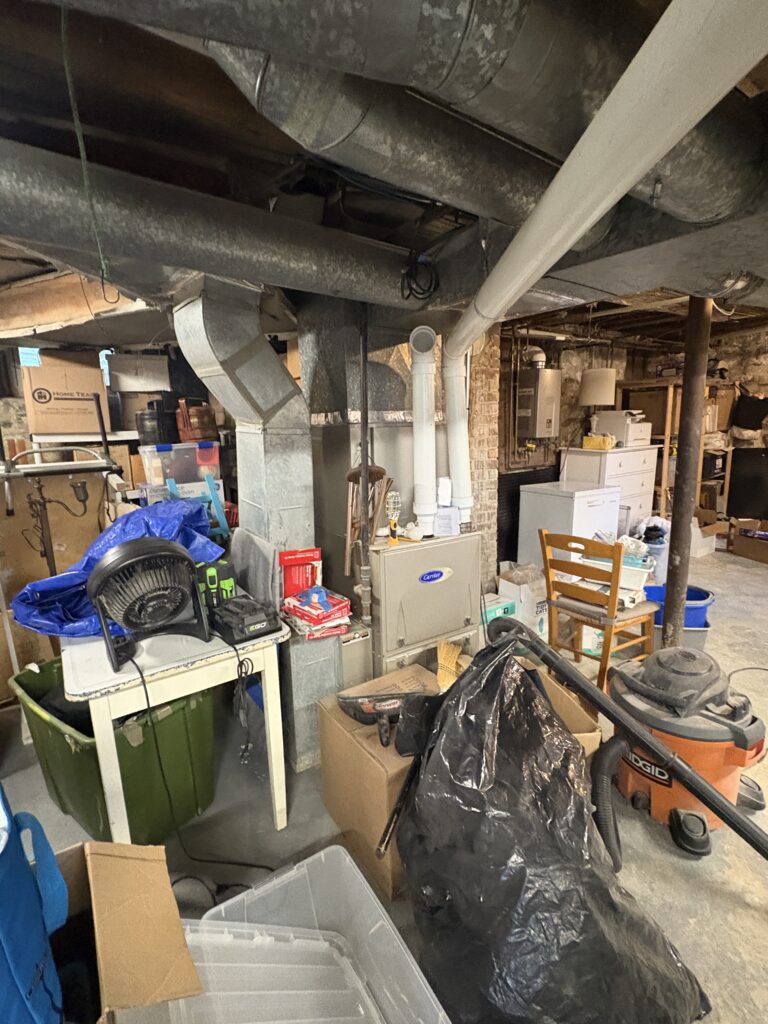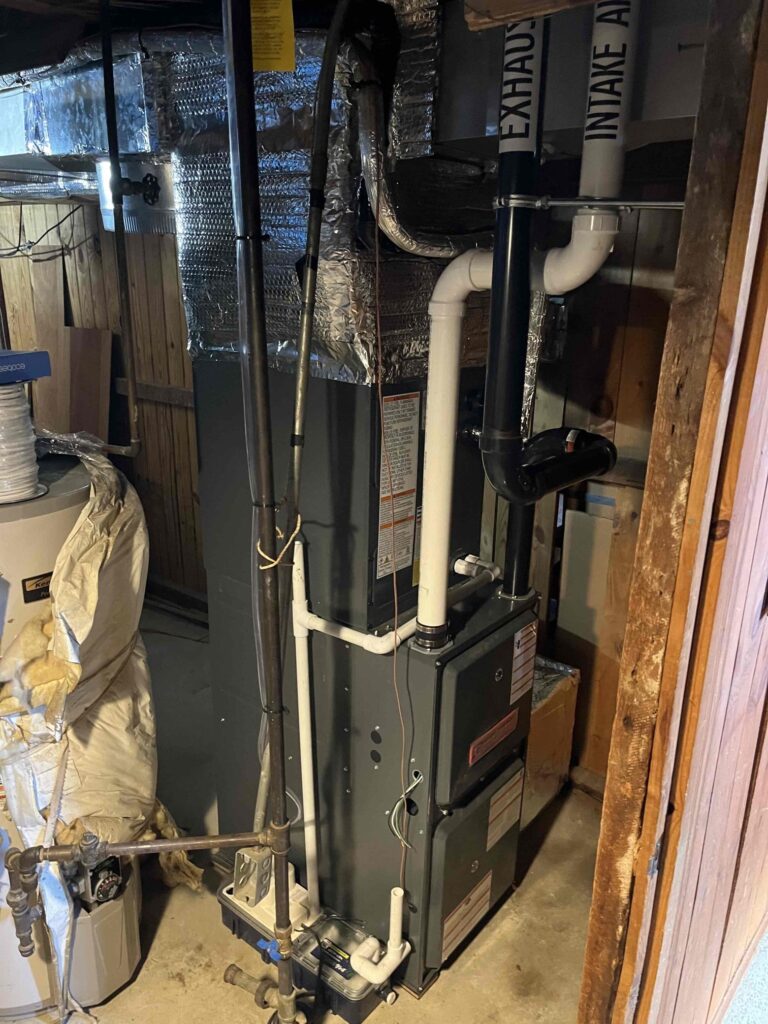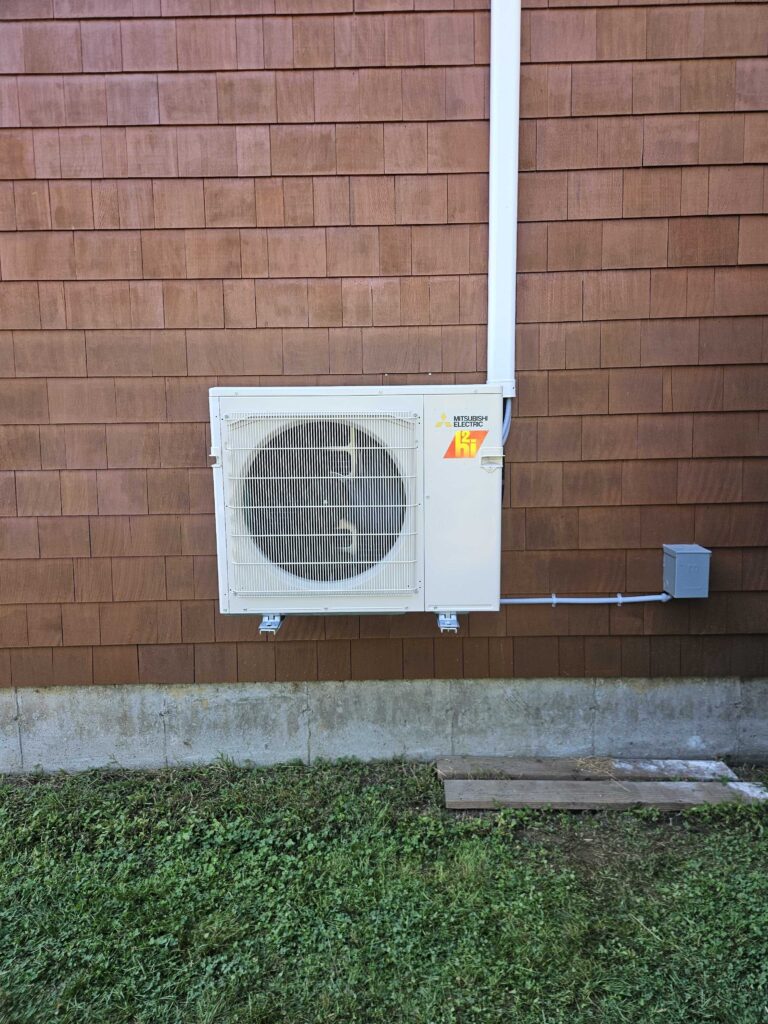Heat Pump Making Strange Noises? Here’s What Each Sound Means
A sudden clang from the backyard unit. A persistent hiss in the basement. If you’re a Massachusetts homeowner who recently invested in a high-efficiency heat pump, those unfamiliar sounds can feel alarming—especially on a frigid January night when comfort matters most.
Understanding what your system is trying to tell you isn’t just about peace of mind; it’s about protecting your investment. According to clear criteria for calling in a professional from ComfortLand, persistent new noises, sounds that grow louder over time, or immediate sharp bangs are all signs that something inside the unit needs attention. Recognizing these warning flags early helps you avoid surprise breakdowns, preserve efficiency, and keep those hard-won Mass Save® energy savings intact.
Table of Contents
ToggleRecognizing Normal Heat Pump Sounds: What’s Okay to Hear
Even the quietest high-efficiency heat pump isn’t completely silent. Before you picture worst-case scenarios, it helps to know the everyday sounds that signal healthy operation.
Here are a few noises you can consider part of your system’s normal soundtrack:
- Gentle humming or whirring from the compressor and motor while the unit runs.
- Light clicking at the start or end of a heating or cooling cycle.
- A brief whooshing or swooshing when the outdoor unit switches into its defrost mode on cold mornings.
Most of these sounds last only seconds and fade into the background. They’re the mechanical equivalent of a car engine idling—evidence that components are powering up, moving refrigerant, and keeping your home comfortable. If the volume, pitch, or duration suddenly changes, though, that’s your cue to pay closer attention.
Gentle Humming and Clicking: Signs of Smooth Operation
As HVAC.com notes, a gentle humming noise usually indicates that the compressor and motor are operating as designed, and a quick click at startup or shutdown is simply the relay engaging. These soft sounds are byproducts of electrical current moving through contactors and coils and should be barely noticeable from inside your home.
If the hum grows louder, takes on a harsh buzz, or the clicking turns into a rapid fire of relay noises, the situation changes. Persistent or escalating sounds can point to issues like a weakening capacitor, loose wiring, or relay failure. When in doubt, shut the system off and schedule a checkup—catching a small electrical hiccup early prevents costly compressor damage down the line.
Whooshing During Defrost: What’s Happening?
During a New England cold snap, your outdoor unit may accumulate frost. To clear that buildup, the heat pump briefly reverses its refrigerant flow in a process called a defrost cycle. The result is a distinct whoosh followed by a few minutes of steam—a normal event you might notice two to three times an hour when temperatures hover near freezing.
Because the defrost cycle is short, anything longer than 10-15 minutes, accompanied by loud clanking or repeated restarts, deserves attention. Keep an eye on the outdoor fan: if ice remains after the cycle or water refreezes quickly, airflow or sensor issues could be hampering the process. When the whoosh becomes a roar or refuses to stop, it’s time to call a pro.
With the everyday soundtrack covered, let’s move on to the impact-style noises—banging, rattling, and knocking—that signal your heat pump may need hands-on help.
Troubling Noises: What Do Banging, Rattling, or Knocking Mean?
When your heat pump trades its usual quiet hum for sudden thuds or metallic rattles, it’s time to investigate. These impact-style noises often point to physical issues inside the unit that can escalate quickly if left unchecked.
Before you reach for the toolbox, review the most common culprits:
- Banging or thumping – often caused by an unbalanced blower wheel, loose motor mounts, or a damaged fan blade.
- Rattling – typically the sound of loose screws, panels, or small parts shaking against the cabinet.
- Knocking – a sign that the fan or motor is wobbling on its axis, creating repetitive, hollow hits.
- Clanging or clunking – may indicate foreign objects (like a twig or rock) striking the fan or interior components.
Routine checks can prevent these noises from becoming full-blown emergencies. Start by shutting off power at the disconnect or breaker, then visually inspect the outdoor unit for loose screws, panels, or obvious debris lodged in the fan. If tightening hardware or clearing obstructions doesn’t restore quiet operation, the problem may be internal and best handled by a professional. What starts as a light rattle can bend fan blades, strain motors, and dent your energy budget.
Next, we’ll focus on electrical buzzing, grinding, and squealing—sounds that demand even greater urgency.
Loose or Broken Components: When to Worry About Rattling or Banging
Impact noises rarely fix themselves. As HVAC.com warns, “Loose, displaced, or broken heat pump components can cause a rattling or banging sound,” and those parts may collide with coils or fan blades, leading to accelerated wear. If the racket is intermittent and tied to windy days, you might be hearing panels vibrating. Tighten screws and ensure the unit sits level on its pad.
However, continuous or worsening clunks, especially during startup, point to bigger issues—think cracked fan hubs or failing motor mounts—that demand prompt, professional repair. Ignoring them can result in higher energy bills, shortened equipment life, or complete system shutdown.
Debris in the Outdoor Unit: Identifying and Fixing the Cause
To rule out foreign objects, turn off the breaker, remove the top grille if it’s safe to do so, and look for sticks, leaves, or gravel inside the cabinet. Gently clear any obstructions, making sure the fan spins freely, and tighten visible screws to curb future vibrations. Regularly skimming debris and keeping shrubs trimmed at least two feet away minimizes the chance of repeat problems, as simple outdoor clean-ups reduce both noise and wear.
If you complete these steps and the thumping soundtrack returns the next time the system cycles on, resist the urge to disassemble further. Shut the unit down and give our team at Endless Energy a call for a thorough internal inspection and repair.
Electrical, Grinding, and Squealing Sounds: Signals of Serious Issues
Most electrical or mechanical failures announce themselves with sharper, more alarming sounds than the gentle hums you’re used to. Listen for the following red flags:
- Electrical buzzing or vibrating that grows louder as the unit runs
- Prolonged, low grinding—almost like metal on metal
- High-pitched squealing or screeching, especially during startup
- Rapid clicking that continues instead of stopping after the cycle begins
Any one of these can point to failing capacitors, loose wiring, worn motor belts, or bearings on their last legs. Because these components power the very heart of your system, delaying service could mean a burned-out compressor and an unwelcome hit to your budget.
Buzzing and Vibrating: Electrical Problems to Watch For
A steady buzz or cabinet-shaking vibration is often a sign that something electrical isn’t seated or functioning correctly. Loose wires, a deteriorating contactor, or a capacitor struggling to store charge can all create that telltale drone. If you notice the outside unit humming loudly—especially during startup—take these steps:
- Switch the thermostat to OFF and cut power at the outdoor disconnect.
- Inspect the cabinet from the outside; don’t open it. Look for visible scorch marks or frayed wiring.
- Call us at Endless Energy. Electrical components carry high voltage even when the unit’s off, so DIY fixes can be dangerous.
If buzzing returns after power is restored—or if the breaker trips repeatedly—keep the unit off and schedule immediate service. Acting quickly protects you from costlier repairs and potential safety hazards.
Grinding, Squealing, or Screeching: Motor and Bearing Concerns
Internal friction sounds rarely end well without professional help. As HVAC.com cautions, “A worn-out fan motor belt within the heat pump’s motor or faulty bearings in the blower motor can lead to high-pitched noises such as squealing or screeching. Contacting a reputable HVAC technician to replace the belt at the first sign of issues can prevent further damage.” Left unattended, these noises can progress from an irritating squeal to a seized motor—often taking other pricey parts down with it.
Not sure what you’re hearing? Try this quick checklist:
- Does the pitch rise and fall with the fan speed? Think motor belt or bearing.
- Is the sound accompanied by reduced airflow or short cycling? Your blower may be overworking to compensate for internal drag.
- Do you smell a hot or burnt odor? Shut the system off immediately; overheating windings could fail at any moment.
When any of these symptoms appear, power down the unit at the breaker, document what you hear (a short phone recording helps), and arrange an urgent repair. Our certified technicians at Endless Energy can replace belts, lubricate bearings, and test electrical components before a minor headache escalates into a system replacement.
With electrical and mechanical alarms covered, let’s turn to another category of sounds—hissing, gurgling, and bubbling—that often point straight to refrigerant trouble.
Hissing, Gurgling, and Bubbling: Refrigerant Leaks and What to Do
Refrigerant is the lifeblood of your heat pump, shuttling heat in and out of your home year-round. When that closed loop develops a leak or pressure imbalance, the system often “speaks up” with unmistakable sounds. Learning to decode these alerts is critical because low refrigerant levels can slash efficiency, hike utility bills, and strain the compressor—the single most expensive component to replace.
Below are the telltale noises that point to refrigerant trouble:
- Hissing – a sharp, steady escape-of-air sound.
- Gurgling – a liquid sloshing or bubbling noise inside the lines.
- Bubbling – similar to gurgling but often louder and accompanied by performance drops.
Hear any of these? Treat them as an urgent call to action rather than background chatter. Here’s why.
Hissing: Spotting and Responding to Refrigerant Leaks
HVAC.com reports that a heat pump hissing noise most often stems from refrigerant escaping a tiny breach in the copper tubing, instantly flashing from high-pressure liquid to low-pressure gas—robbing your system of the precise charge it needs to heat and cool efficiently, and warranting immediate professional repair.
If that high-pitched hiss persists:
- Turn the system off at the thermostat and breaker to prevent further damage.
- Avoid touching any refrigerant lines—exposure can cause frostbite-like injuries.
- Call us at Endless Energy right away. Quick intervention protects the compressor and restores comfort faster than waiting until the next cold snap forces the issue.
Gurgling or Bubbling: What These Sounds Reveal About Your System
According to HVAC.com, “A heat pump gurgling sound is typically caused by the movement of refrigerant through the system, particularly when there’s an uneven flow or air trapped in the lines due to a refrigerant leak or low refrigerant levels. The aforementioned hissing noise may accompany a gurgling sound.”
Because the leak’s exact location can be elusive—and sometimes hidden inside walls—it helps to capture short recordings of the noise and note when it occurs (startup, shutdown, or mid-cycle). Share those details with your technician; they speed up diagnostics and get your heat pump back to peak performance sooner.
Remember, the same professional guidelines we mentioned earlier emphasize acting quickly whenever refrigerant-related sounds appear. Doing so keeps your energy bills in check and extends your system’s lifespan.
Preventing Heat Pump Noise Issues: Maintenance Tips for Massachusetts Homeowners
A quiet heat pump is usually a healthy heat pump. Consistent maintenance not only keeps disruptive sounds at bay but also safeguards efficiency, extends equipment life, and positions you to take full advantage of Mass Save® rebates. The good news? Many noise-prevention steps are simple enough for a Saturday morning.
Before diving in, here’s a quick overview of the habits that pay off all season long:
- Clear leaves, sticks, and snow from around the outdoor unit to maintain steady airflow and reduce vibration.
- Replace or clean air filters every one to three months, depending on usage and household pets.
- Rinse outdoor coils gently with a garden hose when the unit is off to prevent dust buildup.
- Tighten visible screws or panels that may loosen over time.
- Keep indoor vents unblocked and verify that furniture or rugs aren’t restricting airflow.
- Listen for new or changing sounds after storms or yard-work sessions; early detection stops small issues from snowballing.
Sticking to these basics reduces the chance of surprise noises and helps your system run at peak efficiency when temperatures swing from subzero to summer scorchers.
DIY Maintenance: What Homeowners Can Safely Do
Start with tasks that don’t require specialized tools or training. Simple efforts—such as routinely clearing debris from around the outdoor unit or swapping a clogged filter—can eliminate many causes of rattling, buzzing, and airflow strain. Add a monthly “heat-pump check” reminder to your calendar: look for loose screws, ensure the unit sits level, and verify that registers inside remain open and clean.
If you encounter electrical odors, exposed wiring, or persistent grinding and hissing, stop any DIY work immediately. Document what you see or hear, shut the system down at the breaker, and let a licensed technician take it from there. Safety—and warranty coverage—depend on knowing where homeowner maintenance ends and professional service begins.
Professional Inspections: The Value of Annual Service
Carrier’s homeowner maintenance guide emphasizes that scheduling a seasonal professional inspection each spring and fall helps verify refrigerant levels, test electrical components, and catch early signs of wear before they become costly breakdowns. Their recommendations align with our own field experience: a thorough tune-up protects the compressor, maintains manufacturer warranties, and ensures your system meets the efficiency benchmarks required for many rebate programs.
When you schedule an annual visit with our team at Endless Energy, our certified team calibrates controls, lubricates moving parts, and checks for refrigerant leaks—services that keep your heat pump whisper-quiet and performing at its best. Plus, we’ll guide you through the latest Mass Save® incentives so you can offset maintenance or upgrade costs with available rebates.
With a proactive plan in place, you’re well on your way to year-round comfort and confidence.
Take Charge of Your Heat Pump’s Health: Know When to Call Endless Energy
Persistent new noises or sudden spikes in volume should be checked by a technician before minor issues spiral into major repairs. Keeping that guidance in mind, trust your ears—if a sound feels out of character for your system, powering down and getting expert eyes on the equipment is the safest, most cost-effective move.
Ready for professional back-up? Here at Endless Energy, our certified team is here to help you decode any worrisome sounds, restore quiet comfort, and protect your investment—all while guiding you through available Mass Save® rebates. Contact us today for a comprehensive heat pump inspection or schedule a heat pump repair. Let’s keep your home comfortable, efficient, and wonderfully quiet.





